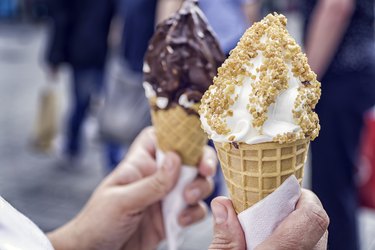
Although ice cream has varying amounts of essential nutrients, including calcium and vitamin A, it isn't exactly considered a health food. Ice cream is mostly made up of fat and added sugar, and the standard 1/2-cup serving often has more than 100 calories.
But what about soft-serve ice cream — how does this lighter, airier version compare with its traditional hard, scoopable counterpart?
Video of the Day
Video of the Day
Tip
Whether soft-serve or regular ice cream is lower in calories depends on the type of regular ice cream you choose. A 1/2-cup serving of either chocolate or vanilla soft-serve ice cream has about 191 calories. The same amount of hard ice cream has about 140 calories.
What Is Soft-Serve?
Soft-serve is a style of ice cream that, as its name implies, is served in a much softer form than traditional ice cream. It's pumped full of air and stored at a slightly higher temperature to maintain this texture. Soft-serve comes out of a machine instead of from tubs or cartons, the way traditional hard ice cream is kept.
Although there is no formal definition of soft-serve set forth by the FDA or USDA, soft-serve usually has between 3 and 6 percent milkfat and is served between 10 and 18 degrees Fahrenheit, according to the United Dairy Institute of Michigan.
Soft-Serve vs. Hard Ice Cream
You might even make the argument that soft-serve is technically not ice cream, at least not according to legal standards.
Ice cream must be made with at least 10 percent milkfat, according to the USDA. Hard ice cream has between 10 and 18 percent milkfat whereas soft-serve has between 3 and 6 percent milkfat, per the United Dairy Institute of Michigan.
Plus, ice cream must weigh a minimum of 4.5 pounds to the gallon, according to the USDA. With its light airiness, soft-serve might not necessarily meet this weight.
While soft-serve is served between 10 and 18 degrees F, traditional hard ice cream is served between 5 and 8 degrees F.
Vanilla
Here's how vanilla soft-serve compares with traditional vanilla ice cream per 1/2-cup serving:
Calories | 191 | 140 |
Fat | 11.2 g | 7.02 g |
Saturated Fat | 6.43 g | 4 g |
Cholesterol | 78.3 mg | 29.9 mg |
Sodium | 52.5 mg | 50 mg |
Carbohydrates | 19.1 g | 17 g |
Fiber | 0.6 g | 0 g |
Sugar | 18.2 g | 14 g |
Protein | 3.53 g | 2 g |
Chocolate
Here's how chocolate soft-serve compares with traditional chocolate ice cream per 1/2-cup serving:
Calories | 191 | 143 |
Fat | 11.2 g | 7.26 g |
Saturated Fat | 6.42 g | 4.49 g |
Cholesterol | 78 mg | 22.4 mg |
Sodium | 52.5 mg | 50.2 mg |
Carbohydrates | 19.1 g | 18.6 g |
Fiber | 0.6 g | 0.79 g |
Sugar | 18.2 g | 16.8 g |
Protein | 3.53 g | 2.51 g |
Is Soft-Serve Healthier Than Ice Cream?
From a nutritional perspective, the difference between soft-serve and hard ice cream is negligible. Saying which one is more nutritious is a difficult question to answer, says dietitian Cameron Currie, RD. "It all depends on the size and type of ice cream," she says.
For example, an ice cream shop might offer premium ice cream, which has higher calories and fat than typical ice cream you'd find at the grocery store.
There's also the question of what toppings you're adding to your ice cream. A 1/2 cup of vanilla ice cream and 1/2 cup of vanilla soft-serve might seem similar, but if you're adding a waffle cone and a ton of sprinkles to your soft-serve order, you've just added many calories and sugar to it as well.
"If you're going to get soft-serve, stick to the cup," Currie says.